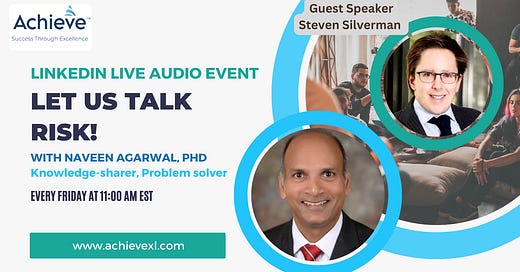Career tip - learn to effectively communicate regulatory risk in business terms
Insights from a Let's Talk Risk! conversation with Steven Silverman
Note: this article highlights key insights gained from a conversation with Steven Silverman as part of the Let’s Talk Risk! with Dr. Naveen Agarwal series on LinkedIn. Listen to the full recording of the discussion below.
M&A1 has traditionally been a strong driver of revenue growth for medical device companies. The current M&A environment, however, is very challenging for companies because of several factors, including declining capital funding and falling market valuations. According to a recent report by E&Y, venture capital was down by 21% and IPOs (Initial Public Offerings) were down by 99% during July 2022-June 2023 compared to a similar timeframe in the prior year2.
Steve shares in this conversation that evaluating regulatory risk3 is particularly challenging for investors because it is often opaque and hard to calculate4. The regulatory environment for medical devices is evolving rapidly in response to advancements in technology such as artificial intelligence and machine learning. One consequence of these rapid macro and micro changes in regulatory requirements is that it becomes challenging to accurately estimate the regulatory risk, both in the pre-market and the post-market phase. The challenge is particularly acute for devices using innovative technologies, where a suitable predicate does not exist to demonstrate substantial equivalence for a faster regulatory review and clearance through the 510k pathway. Even when a suitable predicate can be used, timeline for FDA clearance can range from a few days to more than 2 years5.
Steve shares a cautionary tale of a device firm with a strong product that misunderstood the regulatory path to bring its product to market. As a result, they faced significant delays in getting to market, and severe cash flow constraints for their operations. The firm approached more than 50 investors but could not secure any funding due to a high level of uncertainty in the regulatory process.
According to Steve, investors should not be expected to decipher the nature of regulatory risk for a device firm seeking investment or acquisition.
Device firms are better positioned to identify and explain regulatory risk, from premarket review to post-market oversight. Smart firms describe and quantify this risk for investors. These calculations show expertise, reliability, and strategic and tactical insights. Investors prize these factors when making a deal.
Quality and Regulatory professionals can help bridge this gap, and in doing so, demonstrate the business acumen needed to advance their careers into senior leadership positions. By analyzing the specific regulatory risks, and translating their potential impact in business terms, they can help achieve business goals.
The message is clear - even if you are not in an M&A environment, developing skills in analyzing regulatory risks, and effectively communicating them in business terms, can be a significant competitive advantage for advancing your career.
About Steve Silverman
Steve Silverman is president of The Silverman Group. Steve spent more than a decade at FDA in leadership positions across the Agency. He adds private-sector expertise from consulting and representing industry members. Steve develops strategies that satisfy regulators and promote business needs.
About Let’s Talk Risk! with Dr. Naveen Agarwal
Let’s Talk Risk! with Dr. Naveen Agarwal is a weekly live audio event on LinkedIn, where we talk about risk management related topics in a casual, informal way. Join us at 11:00 am EST every Friday on LinkedIn.
Disclaimer
Information and insights presented in this article are for educational purposes only. Views expressed by all speakers are their own and do not reflect those of their respective organizations.
M&A => Mergers and Acquisitions
Regulatory risk may be evaluated in terms of the likelihood and potential impact of failing to satisfy regulatory requirements applicable to a specific medical device. As an example, failing to adequately demonstrate safety and effectiveness in the pre-market phase can lead to significant delay in regulatory approval or clearance, thus delaying market launch. Warning letters and recalls in the post-market phase add to cost and delays in new product development. Therefore, regulatory risk should be considered to span throughout the lifecycle of a medical device, from pre-market review to post-market compliance.
See for example, a summary of 510k days to decision in the August 2023 Medical Device News Update on Let’s Talk Risk!.




